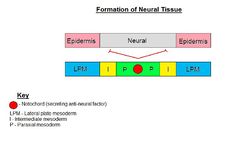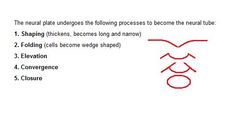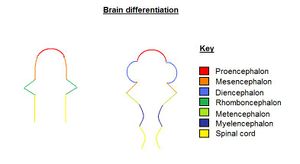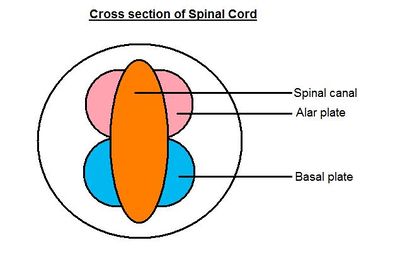CNS Development - Anatomy & Physiology
Introduction
Development of the Central Nervous System (CNS) includes development of the brain, spinal cord, optic and auditory systems, as well as surrounding supporting cells including ependymal cells, astrocytes, oligodendrocytes and microglia. Information within this page will exclude development of the Peripheral Nervous System (PNS) which includes nerve and ganglia formation.
For the appropriate development of the CNS a number of important basic requirements must be achieved. For example, the appropriate haemopoeitic cells must differentiate into specific cells (either neurons or glia) and any axons must extend to appropriate positions in order to form synapses. Development of the CNS is a complex process and complete coordination is required to facilitate the correct procedure of cell differentiation and the establishment of the correct intracellular connections. A range of neurotrophic factors regulate these interactions including FGF, nerve growth factor, laminin, brain derived neurotrophic factor and neurotrophin 3.
Developmental Origins
The embryological origin of the CNS is from the neural ectoderm which is a ridge of tissue in the centre of the early embryo once the basic blastocyst has undergone a degree of differentiation. The neural ectoderm is formed via the thickening of the ectoderm and its interaction with underlying basic neural tissues including the notochord. This interaction results in the formation of the neural plate, termed the neuroectoderm. Below is a diagram of the completed initial stages of development to provide an indication of the anatomy of the development process.
Formation of the neuroectoderm occurs as a result of the folding of the neural plate due to the presence of the Lateral Plate Mesoderm (LPM) factor. The edges of the neural plate begin to fold upwards and inwards, eventually leading to the formation of a neural crest and tube. LPM also initiates the formation of epidermis from ectoderm and therefore areas of ectoderm dorsal to the neural tube differentiate into epidermis.
Neural Development
In the early embryo as shown in the images above, the neural tube is formed and represents the initial stages of the formation of the brain and spinal cord. As the embryo develops, the neural tube continues to develop in conjunction with the formation of the vertebrae of the spine.
Development of Vertebrae
Formation of the cells that will be the precursors to the spinal vertebrae align in an intersegmental fashion to the neural cells of the spinal cord, in a form of bridging pattern. Therefore each neural cell has a spinal vertebrae precursor cell between itself and the adjacent neural cell such that the spinal cell effectively overlaps the edges of two neural cells. This ensures that as the spine and spinal cord develop the spinal nerves become aligned to the spaces between the vertebrae that will eventually become separated by intervertebral discs.
Further along into spinal development, each vertebral body develops three centres of ossification which are separated by cartilage growth plates. Each half of the two vertebral arches that surround the developing spinal cord (neural tube) have their own ossification centre facilitating the development of vertebral processes, ribs and other bone structures related to the LPM including the scapula and pelvis.
Development of the Brain
Development of the brain begins with a series of expansions of the neural tube at the cranial end, giving rise to the internal spaces of the brain, the ventricles and aqueducts. The initial expansion of the neural tube is in the mesencephalon area, or mid brain area. This is then followed by expansions in the rhombencephalon (hind brain) and in the proencephalon (forebrain).
After these initial expansions, a series of further developments occurs to form some of the major landmarks in the brain. The mesencephalon narrows prior to the proencephalon resulting in the formation of the 'Foramen of Munro' and the 'Cerebral Aqueduct'. The proencephalon develops two further pouches in the cranial lateral aspect which are the foundations of the 'Lateral Ventricles' and the 'Third Ventricle'. The rhombencephalon expansion forms the 'Fourth Ventricle' and the 'Central Canal'.
The development of the brain continues with the forebrain out-pouchings developing into hemispheres and growing dorsolaterally, forming the telencephalon. These hemispheres grow over the newly formed diencephalon, mesencephalon and back to the metencephalon. During this stage other developmental landmarks are developed including the Cepahlic flexure, Pontine flexure, Cervical flexure and the myelencephalon. An out-pouching for the cerebellum is also present at this stage of development, together with a choroid plexus (for the production of CSF) and defined lateral ventricles.
In the later stages of development, the brain develops a central sulcus with defined cerebral hemispheres. The telencephalon has gyri and sulci. There is also a defined diencephalon, mid-brain, pons, cerebellum and medulla oblongata. The lumen of the neural tube remains patent within the spinal cord as a narrow central canal.
Formation of the Eyes
The eyes are formed initially from expansion vesicles (called Optic Vesicles) from the lateral ventricles. The outer portion of these vesicles then invaginates resulting in the formation of an optic cup and optic stalk.
Caudal Spinal Cord Development
In late development, the spinal cord extends along the entire length of the spinal canal (formed by the spinal vertebrae). The spinal cord then terminates at the 'conus medullaris' in the middle of the lumbar spine. In adults the spinal cord ends at the beginning of the lumbar spine. Lumbar and sacral nerves extend via the 'cauda equina'.
Therefore in neonates CSF taps must be caudal to the conus medullaris to avoid damaging the spinal cord.
Neuronal Differentiation
Embryonic Orientation
An important element to the development of the CNS is the development and regulation of orientation within the embryo, i.e. which part is cranial, caudal, lateral etc. Within the neural tube this is controlled via HOX (Homeobox) transcription factors which ensure there is an orientation between rostral and caudal. Two HOX genes are expressed resulting in boundaries within the tissue that express that particular gene. One HOX gene is expressed rostrally and the other along the length of the spinal cord. This ensures only appropriate neural development takes place for the given location and orientation.
Within the neural tube there are also controls on orientation that facilitate the development of both dorsal and ventral horns of the spinal cord. An indentation in the neural canal called the Sulcus limitans deliniates the dorsal and ventral columns such that two distinct development 'plates' are formed. The Alar Plate is dorsal and gives rise to sensory neurons whilst the Basal Plate is ventral and gives rise to motor neurons. Both plates give rise to spinal horns from the grey matter of the spinal cord. White matter of the spinal cord arises from the outer margins of the neural tube and is stimulated to develop as axons grow into it from the brain, surrounding ganglia and other areas of the spinal cord.
The dorsal horn tissues eventually fuse allowing the formation of a 'median septum'. Ventral horn tissues expand more fully than the dorsal grey matter tissues and form a 'ventral fissure'.
Neuronal Formation
Within the brain and the spinal cord the fundamental organisation of the neurons is into 'columns' or groupings of cells within both the sensory and motor regions of the brain and within the grey matter of the spinal cord. Groups of neurons with similar functions are able to form 'nuclei'. Cranial nerve nuclei can include both motor and sensory neurons and are able to undertake a wide variety of functions and tasks. Cranial nerves can also convey fibres from multiple cranial nerve nuclei. Within the spinal cord specific columns of neurones, or 'spinal tracts' convey specific information to high centres in the brain.
| This article has been peer reviewed but is awaiting expert review. If you would like to help with this, please see more information about expert reviewing. |
Error in widget FBRecommend: unable to write file /var/www/wikivet.net/extensions/Widgets/compiled_templates/wrt662327a76293a1_95216590 Error in widget google+: unable to write file /var/www/wikivet.net/extensions/Widgets/compiled_templates/wrt662327a76931b0_66686580 Error in widget TwitterTweet: unable to write file /var/www/wikivet.net/extensions/Widgets/compiled_templates/wrt662327a76c2cb1_28348016
|
| WikiVet® Introduction - Help WikiVet - Report a Problem |






